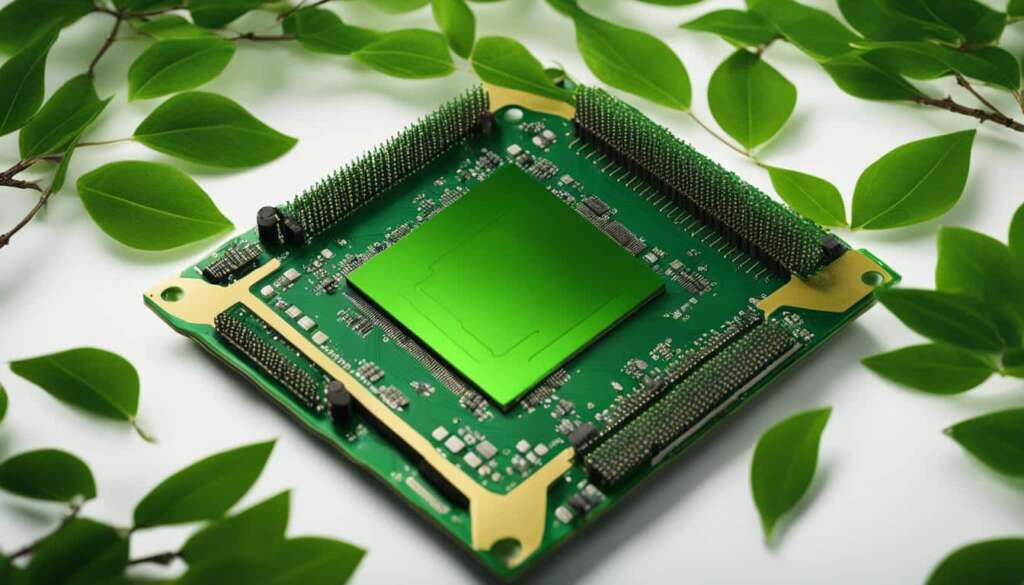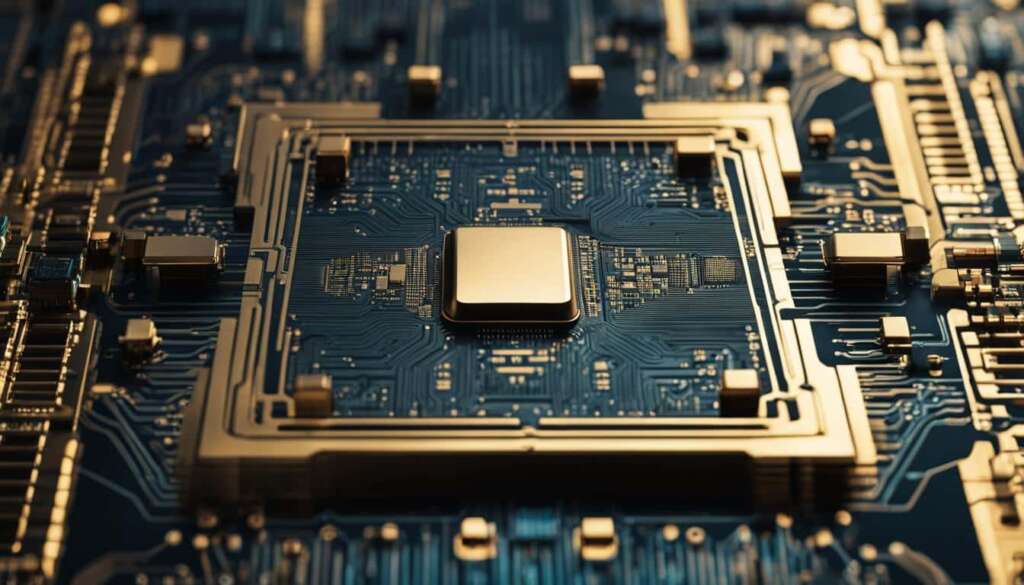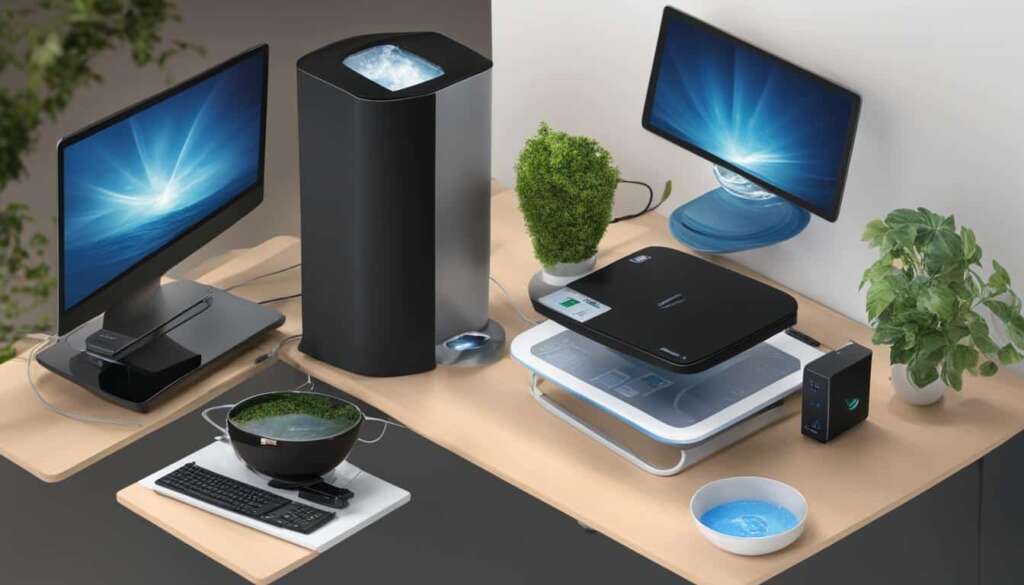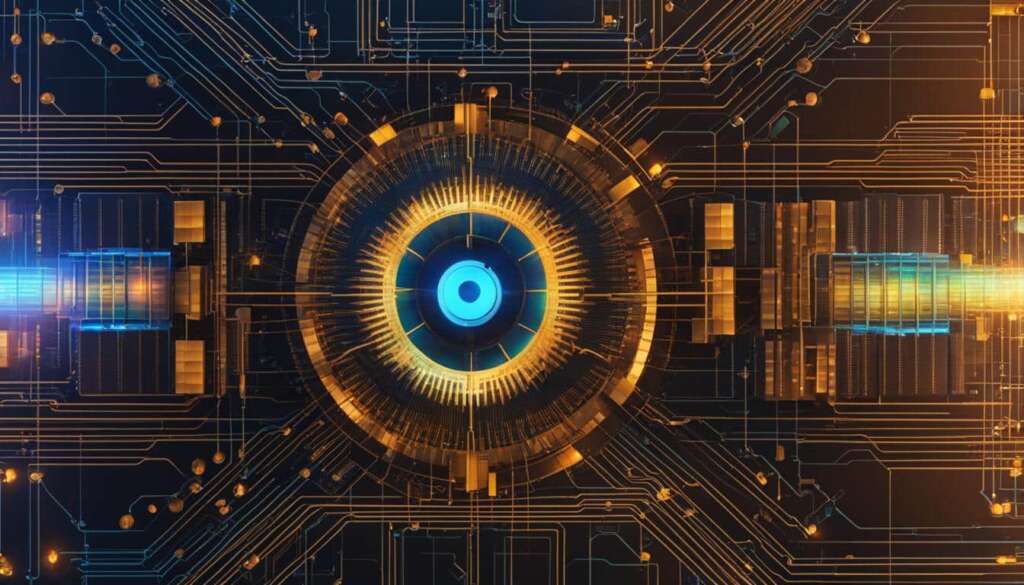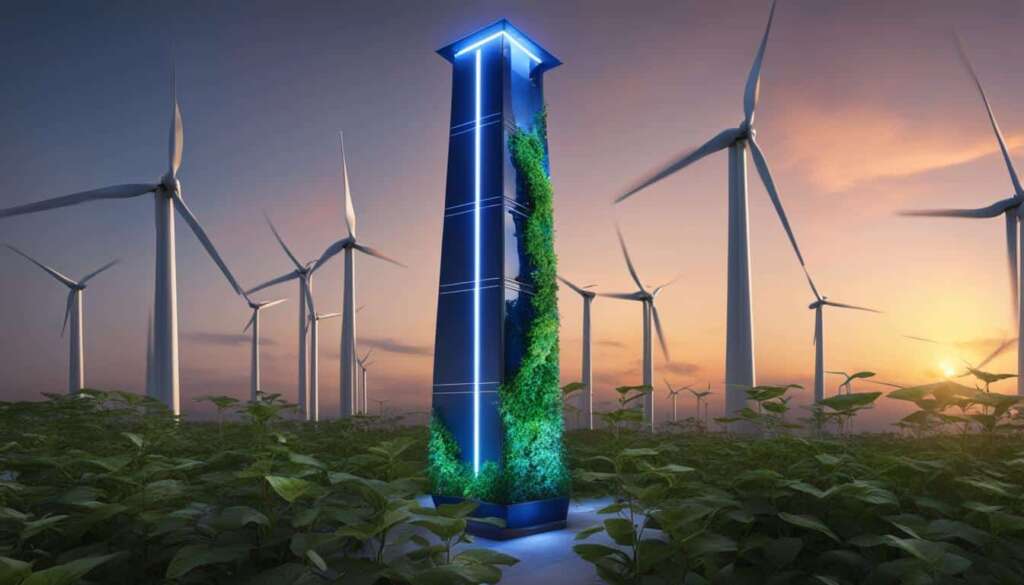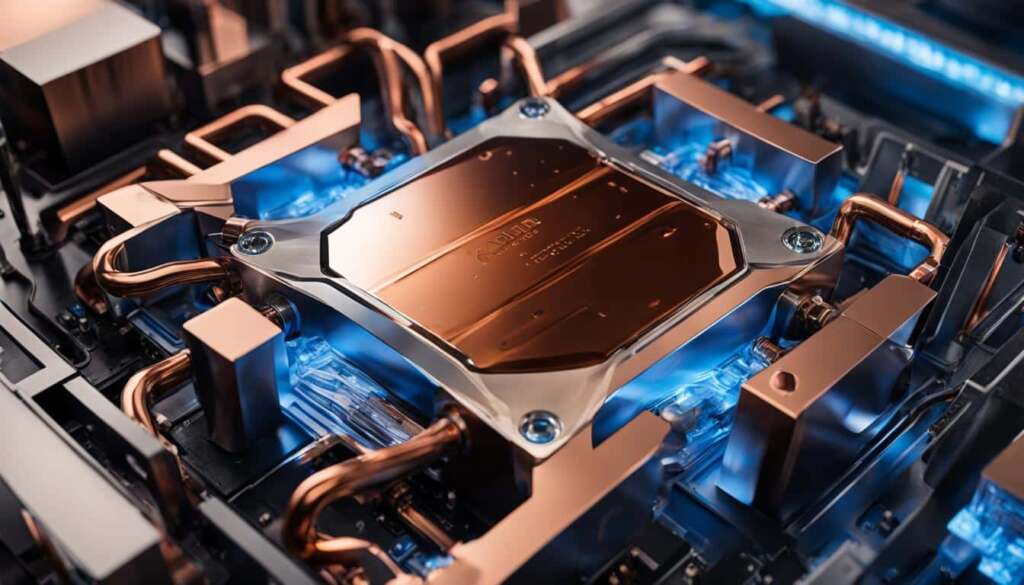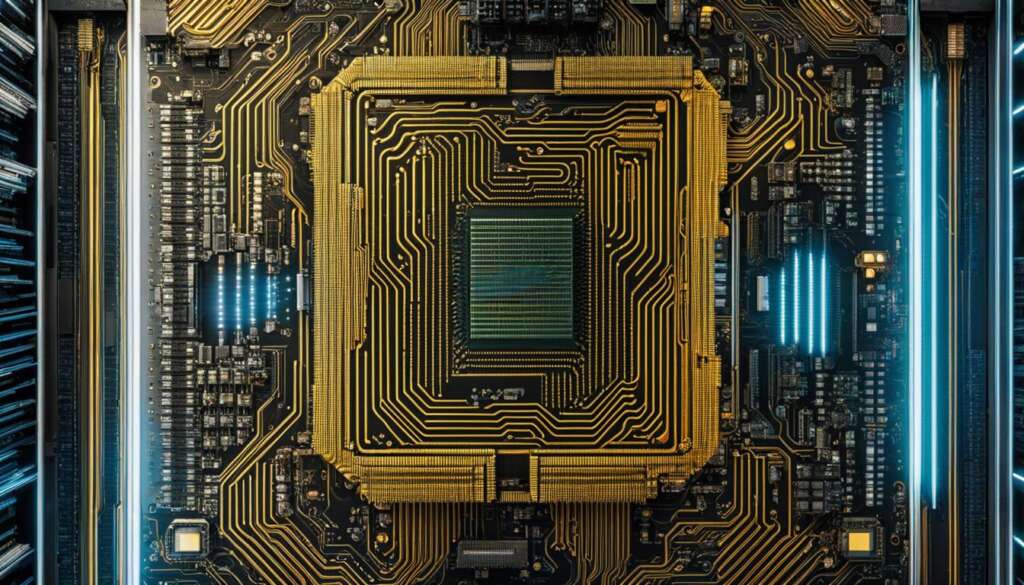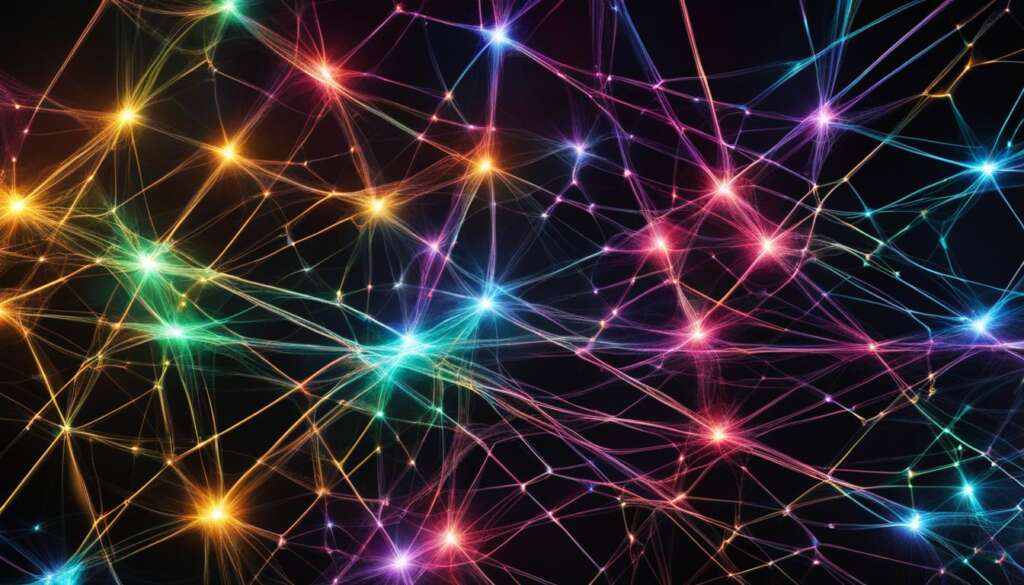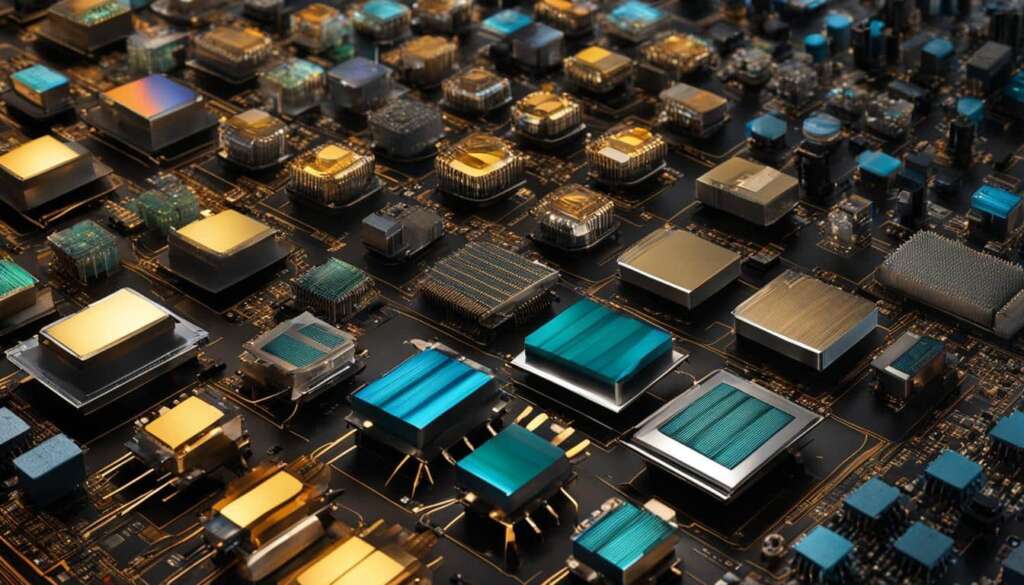Table of Contents
In today’s technology-driven world, the demand for energy-efficient processors is steadily increasing. With a growing emphasis on sustainability and environmental responsibility, industries are seeking low power consumption processors that offer environmentally friendly solutions. Energy-saving CPUs, power-efficient chips, and green processors have become indispensable in this era of energy-efficient computing. In this article, we will explore the development and benefits of energy-efficient processors, as well as their role in sustainable technology.
Energy-efficient processors are designed to perform more functions while using less energy. The perpetual goal of chip manufacturers to create processors with reduced power consumption has resulted in processors that are not only sustainable but also offer advantages in terms of price, time-to-market, flexibility, and reliability. These processors are paving the way for greener technology and energy-saving technology, making a positive impact on both the environment and the bottom line.
The Benefits of Energy-Efficient Hardware
Energy-efficient hardware components, such as low-power consumption CPUs and power management features, offer numerous advantages in terms of performance and sustainability. These advancements optimize computing resources, reduce electricity consumption, and minimize environmental impact.
Improved Energy Efficiency
One of the key benefits of energy-efficient hardware is the optimization of power consumption. Low-power consumption CPUs consume less electricity while maintaining optimal performance. These processors are designed to balance energy usage with computational capabilities, allowing for efficient and sustainable computing.
Furthermore, power management features play a crucial role in enhancing energy efficiency. Features like sleep mode, dynamic frequency scaling, and screen dimming minimize power consumption during periods of inactivity, further reducing overall energy usage.
Virtualization and Cloud Computing
Energy-efficient hardware also enables the implementation of virtualization and cloud computing technologies. By consolidating multiple virtual machines onto a single physical server, these technologies optimize hardware utilization and reduce energy consumption. Virtualization and cloud computing minimize the need for energy-intensive local servers, offering a more sustainable approach to computing.
Responsible Disposal and Recycling
Responsible disposal and recycling of electronic waste associated with energy-efficient hardware components contribute to minimizing environmental impact. When hardware reaches the end of its lifecycle, proper disposal and recycling initiatives ensure the recovery of valuable materials for reuse while preventing harmful substances from entering the environment. By promoting responsible waste management practices, energy-efficient hardware supports a more sustainable and eco-friendly computing ecosystem.
| Benefits of Energy-Efficient Hardware |
|---|
| Improved Energy Efficiency |
| Optimized power consumption |
| Enhanced performance |
| Power management features |
| Virtualization and Cloud Computing |
| Hardware utilization optimization |
| Reduced energy consumption |
| Responsible Disposal and Recycling |
| Minimized environmental impact |
| Recovery of valuable materials |
| Promotion of eco-friendly practices |
“Energy-efficient hardware not only improves performance but also contributes to a more sustainable computing ecosystem.”
In conclusion, energy-efficient hardware offers a range of benefits including improved energy efficiency, virtualization and cloud computing capabilities, and responsible disposal and recycling practices. These advancements not only optimize performance and minimize energy consumption but also contribute to a greener and more sustainable future.
The Role of Green Computing in Sustainable Technology
Green computing plays a crucial role in the development and advancement of sustainable technology. By implementing eco-friendly computing practices, we can significantly reduce energy consumption, minimize environmental impact, and promote a more sustainable future. Green computing encompasses various strategies and solutions aimed at optimizing energy efficiency and reducing the carbon footprint of computer systems and IT operations.
Benefits of Green Computing
Green computing solutions offer numerous benefits, both for businesses and the environment. By adopting energy-efficient hardware and optimizing software, organizations can achieve substantial cost savings through reduced electricity consumption. Additionally, green computing reduces carbon emissions and other harmful pollutants, contributing to a healthier and cleaner environment. It also helps organizations comply with environmental regulations and demonstrate their commitment to sustainability.
- Energy Efficiency: Green computing focuses on developing energy-efficient hardware and software, maximizing performance while minimizing energy consumption.
- Environmental Impact: By reducing carbon emissions and minimizing electronic waste, green computing significantly reduces the environmental footprint of computer technology.
- Cost Savings: Energy-efficient computing results in lower electricity bills and operational expenses, providing long-term cost savings for businesses.
- Sustainability: Green computing promotes the use of renewable energy sources and responsible disposal practices, contributing to a more sustainable and eco-friendly future.
Green Computing Solutions
Green computing encompasses a wide range of solutions and practices that contribute to energy efficiency and sustainability. These include:
- Energy-Efficient Hardware Design: Manufacturers are constantly innovating to develop energy-efficient processors, memory modules, and other hardware components that consume less power.
- Software Optimization: Optimizing software applications and operating systems to reduce power consumption during idle periods and resource-intensive tasks.
- Power Management Techniques: Implementing power management features such as sleep mode, dynamic frequency scaling, and screen dimming to optimize energy usage.
- Virtualization and Cloud Computing: Utilizing virtualization technology and cloud computing services to maximize hardware utilization and reduce energy consumption.
- Recycling Initiatives: Promoting responsible disposal and recycling of electronic waste, ensuring the recovery of valuable materials and minimizing environmental harm.
Embracing green computing not only benefits businesses but also contributes to a greener and more sustainable world. By adopting energy-efficient practices and leveraging innovative solutions, we can minimize our environmental impact and pave the way for a brighter future.
| Benefits of Green Computing | Green Computing Solutions |
|---|---|
| Energy Efficiency | Energy-Efficient Hardware Design |
| Environmental Impact | Software Optimization |
| Cost Savings | Power Management Techniques |
| Sustainability | Virtualization and Cloud Computing |
| Recycling Initiatives |
The Innovations in Energy-Efficient Hardware
In the pursuit of energy efficiency, manufacturers are continuously investing in research and development to design innovative hardware components. These advancements not only contribute to reducing power consumption but also enhance overall computing performance. By adopting cutting-edge hardware design, implementing power management techniques, and integrating efficient cooling systems, energy-efficient processors are revolutionizing the technology landscape.
One key area of innovation in energy-efficient hardware is processor design. Manufacturers are developing processors that strike a balance between performance and power consumption. These energy-efficient processors utilize advanced architectures and manufacturing processes to optimize power utilization, enabling them to deliver high-performance computing capabilities while minimizing energy consumption.
In addition to processor design, power management techniques play a crucial role in energy-efficient hardware. Sleep mode and dynamic frequency scaling are examples of power management features that intelligently adjust power consumption based on system workload. By dynamically reducing power when the system is idle or under low load, energy-efficient hardware can significantly reduce overall power consumption.
Efficient cooling systems also contribute to energy efficiency. Traditional cooling methods often consume a substantial amount of power. However, advancements in cooling technology, such as liquid cooling and intelligent airflow design, have enabled more efficient heat dissipation. These cooling systems help to maintain optimal operating temperatures while minimizing energy requirements, further enhancing the overall energy efficiency of hardware components.
| Innovation | Description |
|---|---|
| Advanced Processor Architecture | Utilizes advanced architectures and manufacturing processes to optimize power utilization, delivering high-performance computing capabilities while minimizing energy consumption. |
| Power Management Techniques | Includes features such as sleep mode and dynamic frequency scaling, which intelligently adjust power consumption based on system workload, reducing overall power consumption. |
| Efficient Cooling Systems | Utilizes technologies such as liquid cooling and intelligent airflow design to dissipate heat more efficiently, maintaining optimal operating temperatures while minimizing energy requirements. |
Power Management Features for Energy Efficiency
Modern operating systems and software applications come equipped with power management features that optimize energy efficiency. These features, such as sleep mode, dynamic frequency scaling, and screen dimming, minimize power consumption during periods of inactivity. Power management can be automated based on user preferences or customizable schedules.
Sleep Mode
Sleep mode is a power-saving feature that puts the computer into a low-power state when it is not actively used. It suspends processes and temporarily disables hardware components, reducing energy consumption. By entering sleep mode, the computer can quickly resume full operation when needed while conserving energy during idle times.
Dynamic Frequency Scaling
Dynamic frequency scaling adjusts the CPU clock frequency based on the workload, allowing the processor to operate at lower frequencies when the demand for processing power is reduced. This feature enables processors to consume less energy by scaling down performance when maximum processing power is not required. As a result, energy-efficient processors can save power without compromising performance.
Screen Dimming
Screen dimming reduces the backlight intensity of the display, conserving power and extending the battery life of portable devices. By adjusting the brightness level, users can customize the screen to a comfortable viewing experience while minimizing energy consumption. Screen dimming is particularly effective during low-light environments and can significantly contribute to energy savings over time.
Virtualization and Cloud Computing for Energy Savings
Virtualization and cloud computing technologies have revolutionized the way computing resources are used and managed. By consolidating multiple virtual machines onto a single physical server, energy consumption can be significantly reduced. This consolidation allows for better hardware utilization, resulting in increased efficiency and reduced energy consumption.
Virtualization enables the creation of multiple virtual machines, each running its own operating system and applications, on a single physical server. This means that fewer physical servers are needed to accommodate the same workload, leading to lower energy requirements for power and cooling. Additionally, virtualization allows for dynamic allocation of resources, ensuring that computing power is utilized optimally based on demand.
Cloud computing takes virtualization a step further by providing remote access to computing resources over the internet. This eliminates the need for energy-intensive local servers and allows organizations to access the necessary computing power on-demand. With cloud computing, businesses can scale their operations efficiently, only utilizing the resources they need at any given time, and reducing energy consumption in the process.

Benefits of Virtualization and Cloud Computing
- Reduced energy consumption: By consolidating multiple virtual machines onto a single physical server, energy usage is minimized, resulting in cost savings and environmental benefits.
- Improved hardware utilization: Virtualization allows for optimal use of computing resources, ensuring that hardware is deployed efficiently and effectively.
- Scalability and flexibility: Cloud computing enables businesses to easily scale their operations up or down based on demand, without the need for physical hardware reconfiguration.
- Cost savings: With virtualization and cloud computing, organizations can save on hardware costs, energy consumption, and maintenance expenses.
In conclusion, virtualization and cloud computing offer significant energy savings and efficiency improvements. By consolidating resources and enabling on-demand access to computing power, these technologies contribute to a more sustainable and environmentally friendly approach to IT infrastructure. As businesses continue to embrace digital transformation, virtualization and cloud computing will play a crucial role in reducing energy consumption and promoting a greener future.
Responsible Disposal and Recycling of Electronic Waste
In the quest for energy-efficient processors, it is essential to address the issue of responsible disposal and recycling of electronic waste. As technology continues to evolve, the rapid obsolescence of electronic devices poses a significant environmental challenge. The improper disposal of electronic waste can lead to the release of toxic materials into the environment and the wasteful depletion of valuable resources. Therefore, implementing effective strategies for the responsible disposal and recycling of electronic waste is crucial for minimizing the environmental impact of the technology industry.
Electronic waste, often referred to as e-waste, encompasses a wide range of discarded electronic devices, including computers, smartphones, and tablets. These devices contain hazardous substances such as lead, mercury, and cadmium, which can contaminate soil, water, and air if not properly managed. To mitigate the environmental risks associated with e-waste, it is essential to establish efficient collection systems and recycling processes.
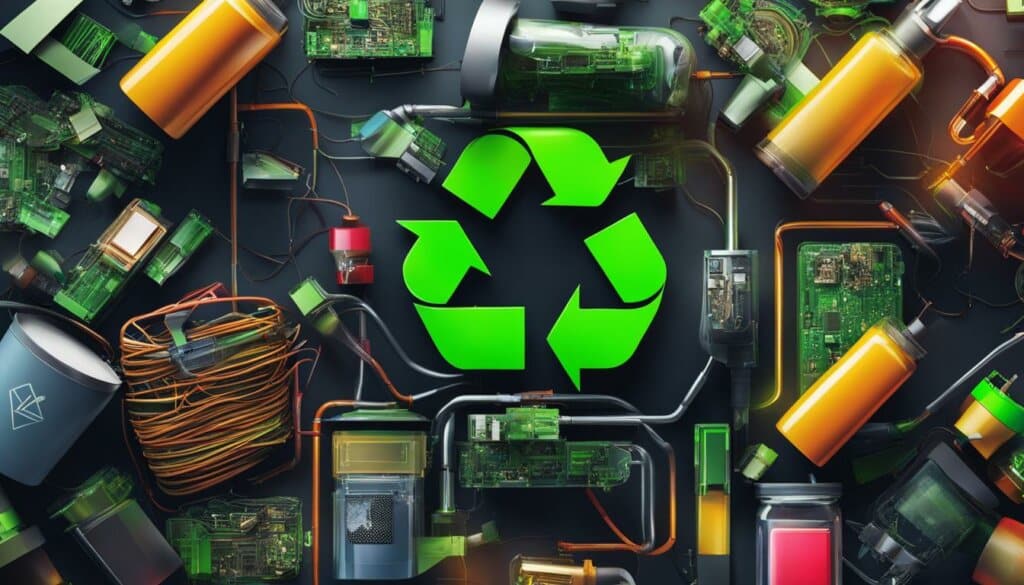
Table: Electronic Waste Statistics
| Year | Global E-waste Generated (Million Metric Tons) | Percentage of E-waste Properly Recycled |
|---|---|---|
| 2015 | 41.8 | 20% |
| 2016 | 44.7 | 20% |
| 2017 | 49.3 | 20% |
| 2018 | 53.6 | 20% |
According to recent data, the global generation of e-waste has been steadily increasing, reaching 53.6 million metric tons in 2018. Unfortunately, only a fraction of this e-waste is properly recycled, with an average recycling rate of 20% in recent years. This highlights the need for greater awareness and effective systems to encourage responsible disposal and recycling efforts.
Responsible disposal and recycling of electronic waste can help recover valuable materials, reduce the demand for raw resources, and minimize the environmental impact of the technology industry. Governments, businesses, and individuals must collaborate to establish comprehensive e-waste management systems, including collection centers, recycling facilities, and awareness campaigns. By adopting these practices, we can ensure a sustainable and greener future for generations to come.
Future Developments in Sustainable Computing
The development of energy-efficient processors has set the stage for exciting future advancements in sustainable computing. As the demand for greener technology increases, researchers are exploring innovative solutions that integrate renewable energy, employ new materials, and harness the power of artificial intelligence (AI) for energy efficiency.
Renewable energy integration is a key focus in sustainable computing. By incorporating solar and wind power into computer devices, the carbon footprint can be significantly reduced. This not only reduces reliance on traditional energy sources but also promotes a greener and more sustainable approach to computing.
| Table: Advancements in Sustainable Computing | |
|---|---|
| Renewable Energy Integration | The integration of solar and wind power into computer devices to reduce carbon footprint. |
| Innovative Materials | The development of new materials that optimize energy consumption and enable sustainable device production. |
| AI for Energy Efficiency | The use of artificial intelligence algorithms to optimize power consumption, load balancing, and resource allocation. |
In addition to renewable energy, the utilization of innovative materials is a promising area of research. By designing hardware components with materials that are both efficient and environmentally friendly, the energy consumption of devices can be further optimized. These materials may also enable the production of more sustainable devices, contributing to a more eco-friendly computing ecosystem.
Artificial intelligence (AI) is revolutionizing energy efficiency in computing. AI algorithms can analyze and optimize power consumption, dynamically adjust frequency scaling, and intelligently allocate computing resources. By leveraging the power of AI, sustainable computing systems can achieve even greater energy efficiency and reduce their environmental impact.
The future of sustainable computing is filled with groundbreaking developments. From renewable energy integration to innovative materials and AI-driven energy efficiency, these advancements hold the key to a greener, more sustainable society. By embracing these future technologies, we can ensure that computing continues to evolve in a way that benefits both the environment and our technological progress.
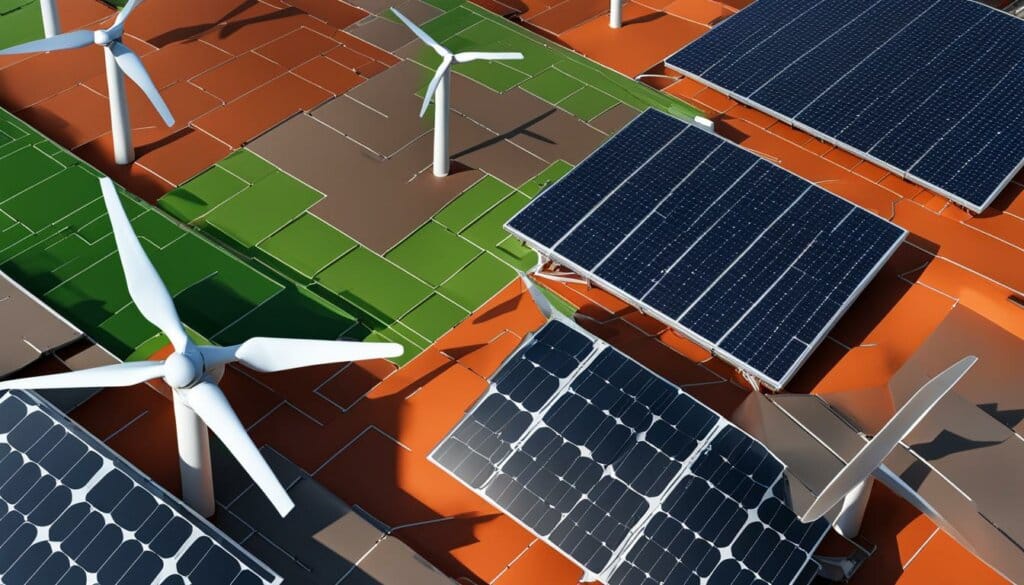
Conclusion
Green computing plays a vital role in harnessing the energy efficiency of computer hardware. By adopting energy-efficient processors and implementing power management features, we can reduce the environmental impact of technology. Sustainability is at the forefront of this movement, aiming to create a greener and more efficient computing ecosystem.
Energy efficiency is a key pillar of green computing. Energy-efficient processors are designed to minimize power consumption while delivering optimal performance. By using these processors, we can significantly reduce our carbon footprint and promote a more sustainable future.
Furthermore, green computing is not just about energy efficiency; it also encompasses responsible disposal and recycling of electronic waste. By properly disposing of old hardware and recycling valuable materials, we can prevent environmental harm and contribute to a circular economy.
Embracing green computing is not only beneficial for the environment but also for businesses. It offers cost savings, as energy-efficient hardware leads to reduced electricity bills. Additionally, it prolongs the lifespan of hardware, reducing the need for frequent upgrades. Adopting sustainable practices also enhances a company’s reputation, as it demonstrates a commitment to environmental stewardship.
Looking ahead, the future of sustainable computing holds exciting developments. Integrating renewable energy sources, such as solar and wind power, into computer devices will further enhance energy efficiency and reduce reliance on fossil fuels. The use of innovative materials and designs will optimize energy consumption, paving the way for the production of more sustainable devices. Furthermore, the application of artificial intelligence algorithms for energy efficiency will optimize power consumption, load balancing, and resource allocation.
In conclusion, green computing is not just a trend; it is a necessity. By prioritizing energy efficiency, promoting sustainability, and minimizing environmental impact, we can create a more efficient and eco-friendly computing environment for generations to come.
FAQ
What is green computing?
Green computing aims to develop and use computer systems with minimal environmental impact, including energy-efficient hardware, optimized software, and responsible disposal of electronic waste.
How does energy-efficient hardware benefit the environment?
Energy-efficient hardware, such as low-power consumption CPUs and power management features, optimizes performance while reducing electricity consumption, contributing to a reduced environmental footprint.
What are some examples of green computing solutions?
Green computing solutions include energy-efficient hardware design, power management techniques like sleep mode and screen dimming, virtualization, and recycling initiatives to minimize the environmental impact of computer technology.
How are energy-efficient processors designed?
Manufacturers invest in research and development to design energy-efficient computer hardware components, including processors, memory modules, and hard drives. Power management techniques and efficient cooling systems further optimize energy consumption.
What are power management features and how do they contribute to energy efficiency?
Power management features, such as sleep mode, dynamic frequency scaling, and screen dimming, minimize power consumption during periods of inactivity, resulting in energy savings.
How does virtualization and cloud computing reduce energy consumption?
By consolidating multiple virtual machines onto a single physical server, virtualization and cloud computing optimize the utilization of computing resources, reducing energy consumption associated with energy-intensive local servers.
Why is responsible disposal and recycling of electronic waste important?
Responsible disposal and recycling initiatives play a crucial role in minimizing the environmental impact of electronic waste generated by computer hardware, enabling the recovery of valuable materials for reuse and reducing environmental harm.
What are future developments in sustainable computing?
The future includes advancements in renewable energy integration, innovative materials and designs for optimized energy consumption, and AI algorithms for further optimizing power consumption, load balancing, and resource allocation.
What are the benefits of embracing green computing?
Embracing green computing offers benefits such as cost savings, extended hardware lifespan, improved reputation, and contributing to a greener, more sustainable society by reducing the environmental impact of technology.

